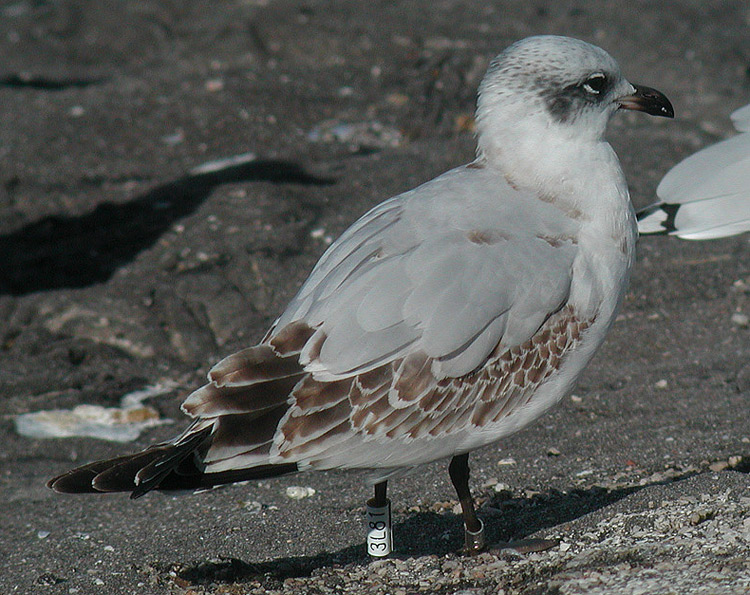Mediterranean Gull 1cy, September 2005, Le Portel /Boulogne-sur-Mer, France (50.42N,1.34E).
Pictures Pim Wolf.
Three different birds from the same date at Le Portel to illustrate variation as the moult to “first-winter” plumage progresses in autumn. Compare these three to the 1cy birds in August, only five weeks earlier.
The complete juvenile plumage lasts for only a short period in Mediterranean Gulls as they start to moult soon after fledging. This post-juvenile moult is a partial moult into so-called "first winter" plumage that starts from the moment the birds leave their colonies in July and will be finished by late September. This moult includes most of the head and body feathers. The head and under-parts become almost completely white, with a dark mask of variable size and intensity behind the eye extending as very narrow streaks over the nape. The eye-crescents are white and the dark smudge in front of the eye contrasts more than in full juvenile plumage. The second generation wing-coverts, mantle and scapular feathers are plain pale grey. The rich brown centres of the juvenile wing-covert centres bleach to a foxy brown and the white fringes quickly wear away. In most birds at least some wing-coverts are included in the post-juvenile moult. The extent of this covert moult is variable, in a few birds nearly all are moulted, in others all juvenile coverts are retained until the next complete moult that starts in May of the next year. All juvenile feathers show wear by September, contrasting with the recently moulted second generation feathers. The base of the bill starts to turn paler and the legs turn slightly paler as well.
Note that the comments on moult are based on observations of juveniles from and in Western Europe. More easterly fledged Mediterranean Gulls may postpone their moult to first winter until later in the autumn and very fresh looking juveniles may be encountered well into October.
Below: Mediterranean Gull 1cy 3L81 September 17 2005, Le Portel /Boulogne-sur-Mer, France (50.42N,1.34E).
Picture Pim Wolf.
Only two months after fledging this bird only superficially resembles a juvenile. The moult to “first winter” plumage is well underway. Most of the mantle and the scapulars are fresh grey feathers, note that some of the lower scapulars are still growing. The moult of the underparts and head has nearly been completed, the underparts are almost completely white, and the head pattern has changed a lot in a few weeks. The crown, chin and neck are pure white with a dark mask behind the eye and black streaks over the nape. This bird has retained its juvenile wing coverts and tertials and those feathers have become moderately worn. The bill is becoming more two-toned with a pinkish base and a dark horn distal two thirds. This bird was ringed as a pullus in the southwest of the Netherlands and would typically have fledged by mid July..

Below: Mediterranean Gull 1cy 3L62 September 17 2005, Le Portel /Boulogne-sur-Mer, France (50.42N,1.34E).
Picture Pim Wolf.
A more advanced bird, again, by this date the moult to “first winter” plumage is well underway. As with the previous bird most of the mantle and all but a few scapulars are fresh grey feathers, and the scapulars are nearly full grown. As usual in Med Gulls the lower row of large scapulars is the last to be replaced. The state of moult of the underparts is difficult to judge on this view but the very white breast and flank indicates that there will be only a few retained brownish feathers, if any. The head moult has been completed, the crown, chin and neck are pure white and the greyish black masks are connected by black streaks that run over the nape. This bird is moulting several median and lower lesser coverts, median coverts and the innermost greater covert. It has also dropped the two uppermost tertials. The pale edges to the tip of the remaining tertials are clearly worn and the pale edges to the tips of the outer primaries are all but worn away. This bird was ringed as a pullus in the southwest of The Netherlands and would typically have fledged by mid July.

Below: Mediterranean Gull 1cy September 17 2005, Le Portel /Boulogne-sur-Mer, France (50.42N,1.34E).
Picture Pim Wolf.
A very advanced bird, all of the mantle and all scapulars are fresh grey feathers, and the scapulars are nearly full grown. The moult of the underparts and head has been completed, the underparts, crown, chin and neck are pure white. The greyish black mask is very faint in this bird. This bird is moulting several median and lower lesser coverts, there is one retained median covert and the two innermost greater coverts are growing. It has also dropped the two uppermost tertials. The bill is very pale for this age-group with a pinkish base and a dark horn distal third.

|
 Mediterranean Gull (L. melanocephalus)
Mediterranean Gull (L. melanocephalus)